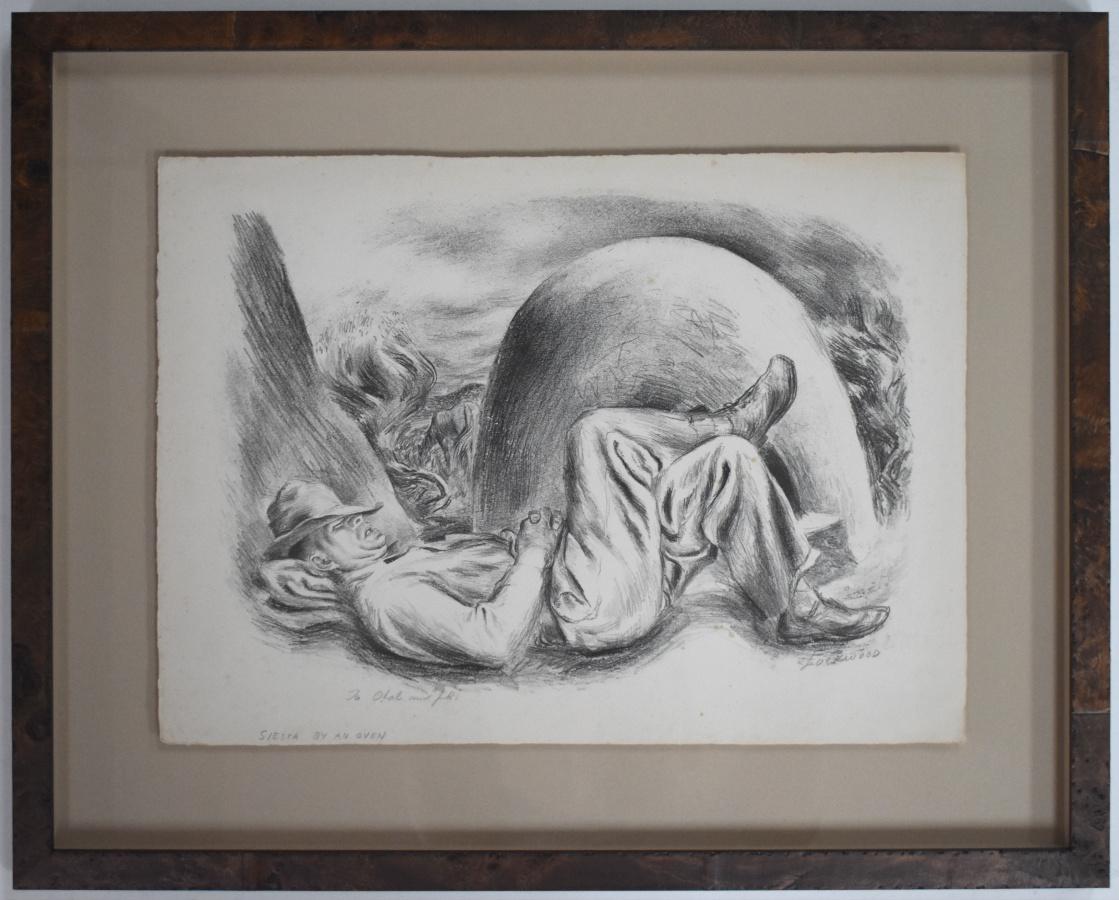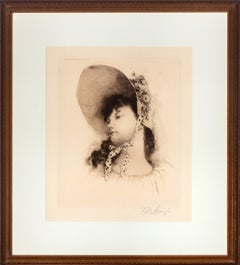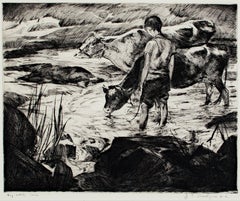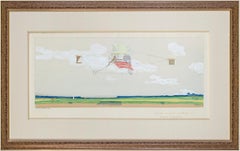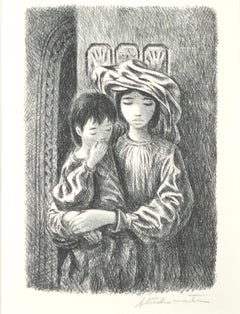Items Similar to "Figure, " Nude Portrait Linoleum Cut signed in Image by Gerrit Sinclair
Want more images or videos?
Request additional images or videos from the seller
1 of 10
Gerrit Sinclair"Figure, " Nude Portrait Linoleum Cut signed in Image by Gerrit Sinclair1936
1936
About the Item
"Figure" is an original linoleum print by Gerrit Sinclair, signed in the lower left hand corner. It features a woman fixing her hair in front of a mirror, her nude body visible to the viewer from the back and front reflecting in the mirror.
Image: 6" x 5"
Framed: 13.37" x 12.43"
Gerrit Sinclair brought the charming style of American Regionalism painting to the masses. Gerrit Sinclair was one of Wisconsin's premier chroniclers of middle-class America during the first half of the 20th century. Sinclair's paintings express mood and narrative. Often idyllic, his stylized paintings capture a slower and more relaxed time and place that perhaps existed more as a state of mind than a condition of reality. Sinclair arrived in Wisconsin in 1920 when he joined the art faculty of the Layton School of Art (Milwaukee). He continued to actively create and exhibit his work until around the end of World War II. His work includes images of daily life as it unfolded in the environment of close-knit city neighborhoods, small town and rural Wisconsin. A few of his paintings reflect his own military service experiences of World War I. Artist and educator Gerrit V. Sinclair left a legacy to savor. His paintings capture the essence of life and the times, highlighting his surroundings, no matter where he was. For more than thirty years he depicted Wisconsin's landscapes, towns, lakes, homes, people involved in daily activities, capturing how man worked and relaxed. Unlike many earlier Wisconsin artists, he was not trained in the German academic tradition but rather in a newer modernist style of American Art garnered, no doubt, through his studies at The Art Institute of Chicago. His works reveal Sinclair's perception of local life experience in mid-America. He contrasts urban life settings and activities with the serenity and integrity of the countryside. The reality of each scene is palpable. Although each painting carries a theme of place, that place is universal enough to have broader significance.
- Creator:Gerrit Sinclair (1890 - 1955, American)
- Creation Year:1936
- Dimensions:Height: 13.37 in (33.96 cm)Width: 12.43 in (31.58 cm)
- Medium:
- Movement & Style:
- Period:
- Condition:
- Gallery Location:Milwaukee, WI
- Reference Number:Seller: 13949g1stDibs: LU60534923081
About the Seller
4.9
Gold Seller
Premium sellers maintaining a 4.3+ rating and 24-hour response times
Established in 1966
1stDibs seller since 2017
429 sales on 1stDibs
Typical response time: 2 hours
- ShippingRetrieving quote...Shipping from: Milwaukee, WI
- Return Policy
Authenticity Guarantee
In the unlikely event there’s an issue with an item’s authenticity, contact us within 1 year for a full refund. DetailsMoney-Back Guarantee
If your item is not as described, is damaged in transit, or does not arrive, contact us within 7 days for a full refund. Details24-Hour Cancellation
You have a 24-hour grace period in which to reconsider your purchase, with no questions asked.Vetted Professional Sellers
Our world-class sellers must adhere to strict standards for service and quality, maintaining the integrity of our listings.Price-Match Guarantee
If you find that a seller listed the same item for a lower price elsewhere, we’ll match it.Trusted Global Delivery
Our best-in-class carrier network provides specialized shipping options worldwide, including custom delivery.More From This Seller
View All"Young Girl With Hat, " Victorian Portrait Etching signed Frederick M. Spiegle
By Frederick M. Spiegle
Located in Milwaukee, WI
"Young Girl With Hat" is a classical Victorian portrait etching. It is signed in graphite in the lower right by the artist, F.M. Spiegle. It depicts a Victorian girl with curly hair ...
Category
1880s American Realist Portrait Prints
Materials
Etching, Paper
20th century drypoint etching figurative animal print black and white signed
By John Edward Costigan
Located in Milwaukee, WI
"Boy With Cows" is an original drypoint etching by John Edward Costigan. It depicts a young boy with three cows standing in a watering hole. The artist si...
Category
1930s American Realist Figurative Prints
Materials
Drypoint, Etching
'Coupe Gordon Bennett 1909' original lithograph by Marguerite "Gamy" Montaut
By Marguerite Montaut
Located in Milwaukee, WI
"Coupe Gordon Bennett 1909 — Curtiss le Gagnant" is an original Lithograph with Pochoir created by Marguerite Montaut (GAMY). Gamy presents the viewer w...
Category
Early 1900s American Realist Landscape Prints
Materials
Lithograph, Ink
"Arab Children, " Portrait of Two Figures Lithograph signed by Fletcher Martin
By Fletcher Martin
Located in Milwaukee, WI
"Arab Children" is an original lithograph by Fletcher Martin. The artist signed the piece lower right. This piece features two young children--a boy and a girl--with downcast eyes in draped fabric clothes in an interior.
12" x 8" art
22" x 18" frame
Fletcher Martin was an American painter, illustrator, muralist and educator. He is best known for his images of soldier life during World War II and his sometimes brutal images of boxing and other sports. His artistic skills were largely self-taught.
He worked as a printer in Los Angeles in the late 1920s, and as an assistant to Mexican muralist David Alfaro Siqueiros in the early 1930s. He taught at local art schools such as Otis Art Institute.
He won commissions to paint murals for the New Deal's Section of Painting and Sculpture, including Mail Transportation (1938), painted for the San Pedro Federal Building and Post Office in Los Angeles. Under the WPA he painted a mural study for the Kellogg, Idaho post office titled Mine Rescue (1939). Local industrialists objected that it depicted the dangers of mining, while officials of the Mine & Smelt Workers Union praised it. The industrialists prevailed and Martin painted an uncontroversial mural, Discovery (1941), depicting the prospector who founded the town. The rejected mural study is now in the Smithsonian American Art Museum. Perhaps his most ambitious mural, also done under the WPA, was painted for North Hollywood High School in Los Angeles. Legends of Fernandino and Gabrileno Indians (1937) depicts overlapping scenes of Native American life and ritual, and the world being carried on the backs of giants.
As an artist-correspondent for Life Magazine during World War II, he made hundreds of sketches of U.S. soldier life. Fourteen of his paintings from the North African campaign were published in the December 27, 1943 issue of Life, and brought him national recognition. Among these was Boy Picking Flowers...
Category
1940s American Realist Figurative Prints
Materials
Lithograph
"French Air Show with Remarque of Head of Pilot, " Lithograph & Stencil by GAMY
By Marguerite Montaut
Located in Milwaukee, WI
"French Air Show with Remarque of Head of Pilot" is an original lithograph and stencil print by Marguerite Montaut (GAMY). It depicts an early airplane flying above a crowd of specta...
Category
1910s American Realist Landscape Prints
Materials
Lithograph, Stencil, Ink
Contemporary color lithograph nude female figures horses red black signed
By Philip Pearlstein
Located in Milwaukee, WI
"Models & Horses" is an original color lithograph by Philip Pearlstein. The artist signed the piece lower left and it is edition 15/140. This piece features two nude female models lo...
Category
1990s American Realist Figurative Prints
Materials
Lithograph
You May Also Like
chrysanthemum
Located in San Francisco, CA
This artwork "chrysanthemum" is an original linocut print on paper by American botanical artist Henry Evans, 1918-1990. It is hand signed, titled, dated and numbered 213/320 in penc...
Category
Late 20th Century American Realist Figurative Prints
Materials
Linocut
Worm Wood
Located in San Francisco, CA
This artwork titled "Worm Wood" is an original linocut print on paper by American botanical artist Henry Evans, 1918-1990. It is hand signed, titled, dated and numbered 185/200 in p...
Category
Late 20th Century American Realist Figurative Prints
Materials
Linocut
Wuxtry! [Extra!]
By Albert Abramovitz
Located in New York, NY
Albert Abramovitz (1879-1963), Wuxtry! [Extra?!], linocut in colors, c. 1936, signed in pencil lower right and titled lower center [also initialed in the plate]. In very good conditi...
Category
1930s American Realist Figurative Prints
Materials
Linocut
Peaches
Located in San Francisco, CA
This artwork titled "Peaches" 1976, is an original color linocut print on paper by American botanical artist Henry Evans, 1918-1990. It is hand signed, titled, dated and numbered 53...
Category
Late 20th Century American Realist Figurative Prints
Materials
Linocut
"SIESTA BY AN OVEN" LITHOGRAPH BY EARLY TEXAS & NEW MEXICO ARTIST OUTDOOR OVEN
By Ward Lockwood
Located in San Antonio, TX
Ward Lockwood
(1894 - 1963)
New Mexico, Texas, Kansas / Mexico Artist
Image Size: 12 x 16
Frame Size: 17.75 x 21.75
Medium: Charcoal
"Siesta By The Oven"
Biography
Ward Lockwood (1894 - 1963)
Born in Atchison, Kansas, Ward Lockwood became a key painter in the Taos, New Mexico art colony, but diverse modernist art styles including Expressionism*, Cubism*, Surrealism* and Constructivism* reflected his wide ranging travels in Europe and the United States. From the 1920s to the 1960s, his work embraced a series of stylistic changes characteristic of people who influenced him, including John Marin and Andrew Dasburg.
He studied at the University of Kansas, and from 1914 to 1917 at the Pennsylvania Academy of Fine Arts* where he was introduced to Modernism*. In 1917, he began a two-year enlistment in the Army and served in France, and in 1921, a return visit to France led to his being influenced by Paul Cezanne and Vincent Van Gogh.
During this time, he studied in Paris at the Academie Ranson*, but got bored with the academic climate of that school and spent time at the Louvre and galleries along the Rue de la Boetie. He painted from local models and traveled around France with fellow Kansan, Kenneth Adams. He was much impressed with the diversity of contemporary art movements including Futurism*, Cubism, and Dadaism*. His work from this period shows influences of Geometric Abstraction* and Impressionism.
In 1922, he returned to Kansas, committed to the idea that an artist does best painting in his own culture. He worked as a commercial artist and also did portrait commissions.
In 1926, he and his wife, artist Clyde Bonebrake, moved to Taos, New Mexico because of his friendship with Kenneth Adams, who was already established there. Lockwood became interested in the Taos Society of Artists...
Category
1950s American Realist Figurative Prints
Materials
Lithograph
'Goin' Home' — WPA Era American Regionalism
By Thomas Hart Benton
Located in Myrtle Beach, SC
Thomas Hart Benton, 'Goin' Home', lithograph, 1937, edition 250, Fath 14. Signed in pencil. Signed in the stone, lower right. A fine, richly-inked impression, on off-white, wove paper, with margins, in excellent condition. Published by Associated American Artists. Archivally matted to museum standards, unframed.
Image size 9 7/16 x 11 7/8 inches; sheet size 10 3/4 x 13 5/16 inches.
Impressions of this work are held in the following museum collections: Figge Art Museum, Georgetown University Art Collection, Indianapolis Museum of Art, Library of Congress, Metropolitan Museum of Art, and the Nelson-Atkins Museum of Art.
ABOUT THE ARTIST
“Benton’s idiom was essentially political and rhetorical, the painterly equivalent of the country stump speeches that were a Benton family tradition. The artist vividly recalled accompanying his father, Maecenas E. Benton — a four-term U.S. congressman, on campaigns through rural Missouri. Young Tom Benton grew up with an instinct for constituencies that led him to assess art on the basis of its audience appeal. His own art, after the experiments with abstraction, was high-spirited entertainment designed to catch and hold an audience with a political message neatly bracketed between humor and local color.”
—Elizabeth Broun “Thomas Hart Benton: A Politician in Art,” Smithsonian Studies in American Art, Spring 1987.
Born in 1889 in Neosho, Missouri, Thomas Hart Benton spent much of his childhood and adolescence in Washington, D.C., where his father, Maecenas Eason Benton, served as a Democratic member of Congress from 1897 to 1905. Hoping to prepare Benton for a political career, his father sent him to Western Military Academy. After nearly two years at the academy, Benton persuaded his mother to support him in attending the Art Institute of Chicago for two years, followed by two additional years at the Académie Julian in Paris.
In 1912, Benton returned to America and moved to New York to pursue his artistic career. One of his first jobs involved painting sets for silent films, which were being produced in Fort Lee, New Jersey. Benton credits this experience with equipping him with the skills necessary to create his large-scale murals.
When World War I broke out, Benton joined the Navy. Stationed in Norfolk, Virginia, he was assigned to create drawings of camouflaged ships arriving at Norfolk Naval Station. These renderings were used to identify vessels that might be lost in battle. Benton later remarked that being a "camofleur" profoundly impacted his career: "When I came out of the Navy after the First World War," he said, "I made up my mind that I wasn’t going to be just a studio painter, a pattern maker in the fashion then dominating the art world—as it still does. I began to think of returning to the painting of subjects, subjects with meanings, which people, in general, might be interested in."
While developing his Regionalist vision, Benton also taught art, first at a city-supported school and later at The Art Students League from 1926 to 1935. One of his students was a young Jackson Pollock, who regarded Benton as both a mentor and father figure. In 1930, Benton was commissioned to paint a mural for the New School for Social Research. The "America Today" mural, now permanently exhibited at the Metropolitan Museum of Art, led to many more commissions as Benton’s work gained wide recognition.
The Regionalist Movement became popular during the Great Depression of the 1930s. Painters such as Benton, Grant Wood, and John Steuart Curry rejected modernist European influences, choosing instead to depict realistic images of small-town and rural life—comforting representations of the American heartland during a period of upheaval. Time Magazine referred to Benton as "the most virile of U.S. painters of the U.S. Scene," featuring his self-portrait on the cover of a 1934 issue that included a story titled "The Birth of Regionalism."
In 1935, Benton left New York and returned to Missouri, where he taught at the Kansas City Art Institute. His outspoken criticism of modern art, art critics, and political views alienated him from many influential figures in both political and art circles. Nonetheless, Benton remained true to his beliefs, continuing to create murals, paintings, and prints that captured enduring images of American life. The dramatic and engaging characteristics of Benton’s artwork drawn the attention of Hollywood producers, leading him to create illustrations and posters for films, including his famous lithographs for the film adaptation of John Steinbeck’s "The Grapes of Wrath," produced by Twentieth Century Fox.
During the 1930s, The Limited Editions Club of New York asked Benton to illustrate special editions of three of Mark Twain’s books...
Category
1930s American Realist Figurative Prints
Materials
Lithograph
